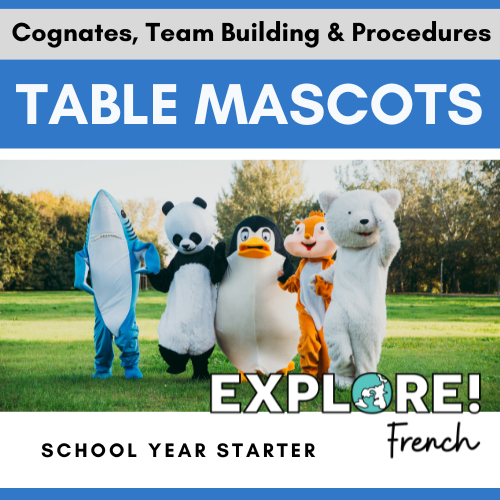The First Day of World Language Class
Begin the School Year by answering students’ unspoken questions and communicating clear expectations
It’s that time again - back to school! I’ll be honest - I LOVE the first weeks of school, especially in my level 1 language classes.
Even the ‘coolest’ teenager can’t fool me - they may look composed, or even indifferent, but underneath their new backpacks, sharpened pencils, and squeaky-clean tennis shoes, they have all the same feelings they had on their first day of kindergarten; excitement, anticipation, a little nervousness, maybe some fear and - most of all - a lot of burning questions:
Question 1: Will I be embarrassed?
Question 2: Who is the teacher?
Question 3: Who are my classmates?
Question 4: How hard will it be to learn French or Spanish?
Question 5: What will I be doing?
Question 6: Will it be boring?
If kids are coming from previous language-learning experiences, they may already have answers to some of these questions. They might have loved their previous classes, but I’ve often found in Level 1 or 2 in particular, some large percentage of my students had a prior bad experience with language learning. These kids DON’T want to be here and are dreading the weeks and months ahead. I design a lot of my first lessons with these students in mind; I hope I can show them evidence that might help them change their minds about learning French or Spanish.
Along those lines, think about each activity you do on the first day of class. If you were a student in your class, how would you feel about the prospect of spending months in this environment?
Here are a few of my favorite activities which, I’ve found, help give positive answers to students; first-day-of-school questions.
Question 1: Will I be embarrassed?
There are quite a few ways students can be embarrassed on the first day of class. Not being in the right classroom or seat is a big one. I help mitigate this by standing at the door, welcoming students to the class by name, and directing students to a clearly labeled seat - ideas from Harry Wong’s excellent book, “The First Days of School” I always have something on their desk for students to begin working on (often a ‘get to know you’ survey like this one). Having their name publicly mispronounced is another big embarrassment for some kids, so I don’t read the roster aloud for attendance. Instead, as kids work I walk around the room and meet students table by table. I ask students to pronounce their names for me and take careful notes. I mark my attendance roster as I go. No embarrassing, public mispronunciations involved.
In addition to avoiding embarrassment, meeting students in small groups as they work avoids starting class with a boring, teacher-centric roll call. It gives me a brief chance to interact with each individual student. I try to send the message in these first interactions that “I see you, I’m interested in you, and you belong here!”
Question 2: Who is the teacher?
I love to start class with a fun “Meet The Teacher” multiple choice game via Kahoot or whiteboards. This gives me a chance to briefly discuss expectations for participation and some classroom procedures. It also gives me a chance to show a few fun photos of my pet hedgehog and my middle-school style from the 80’s (I ROCKED that perm!) I borrowed this idea from my amazing colleague, Shelby Cole, and you can find a ready-to-edit template on my TPT store!
Question 3: Who are the other kids in this class?
After the Meet the Teacher quiz, I like to do some sort of icebreaker activity in small groups. This can take different forms, but there are a few non-negotiables. First, some students aren’t ready to open up to an unknown group of peers, and I want to respect that! I’ve found loosely structured trivia games like this FREE Get to Know You Activity are good for allowing students to share at a depth they are comfortable with.
Some kids HATE ice-breakers, and the big objections seem to be that they take a long time and there’s no way to remember all those kids' names at once. Doing icebreakers in a small group eliminates both of these problems; the process is a little more personal, a little more memorable, and moves along much faster than sludging through all 30 students.
My favorite team building activity for the first weeks of level 1 world language class is my “Table Mascots” activity. I use it over several class periods to build collaborative teams and teach classroom procedures, while introducing cognates and teaching simple personal descriptions. Click the images below to access these lessons in your language of choice.
Along those lines, another non-negotiable is that students in my class must learn each other’s names starting with their table group. By the end of day 1, students should know the names of the 3-4 other students at their table. Yes, this will be on the quiz! (Read more in my blog post about building classroom community)
Question 4: How hard will it be to learn French or Spanish?
“Walking through the syllabus is teacher driven, and the student is completely passive.”
At this point in class, we jump in and learn a bit of content. In upper levels, I find a fun target language Instagram Post or online Top 10 list to look at. For level 1, I always introduce the numbers from 1-10. This is a really important moment (as I discuss in my blog post about teaching numbers here). For a lot of students, this is their very first exposure to language learning! For students who have studied the target language before, it’s their introduction to how things work in this class. Whatever content you introduce, be sure it’s engaging, interactive, and that students can leave class with a sense of accomplishment. Please don’t hand students a vocabulary list on this first day! Instead, set an early expectation that every student will be working every day in this classroom. Or, to answer your question, dear student - YES you can learn the target language, and with effective study techniques it will be challenging but manageable!
Question 5: What will I be doing?
By the end of the first day of class, students will have formulated an answer to this question. With thoughtful introductory activities, students will recognize:
I will have personal contact with a teacher who is interested in me.
I will be active throughout the entire class.
I will interact using technology or personal responses.
I will participate in collaborative groups and I will get to know my group members.
I will speak and listen.
I will demonstrate my learning through active participation.
I will be challenged.
I can be successful.
Question 6: Will it be boring?
Hopefully not! Some students already have their minds made up about school and boring-ness before they ever walk into your classroom. You cannot change their mind. Only a student can change his or her own mind. What you CAN do is provide enough evidence - in the form of interactive, challenging activities - for your students to conclude that learning a language is one of life’s most rewarding undertakings!
One final note
You may have noticed that I don’t hand out a syllabus or discuss classroom rules on the first day of school. This is intentional. Walking through the syllabus is teacher driven, and the student is completely passive. Depending on the presentation, it can come across as very rigid. In any case, as a student, I’m getting this exact lesson in most or all of my classes today. There’s no ability to get to know my peers, nor really to get to know the teacher, no opportunity to learn or demonstrate my learning. Each of these messages is the opposite of what I want to communicate to students on Day 1!
“Set an expectation from the first day of school that every student will be working every day in this classroom”
For this reason, I don’t introduce my syllabus for several days. Instead, as we do each activity, I share classroom procedures and rules as we go. For example, on the first group work activity, I’ll mention “I do have a few expectations for group work. Here they are…” When a student asks to use the restroom, I’ll pause class and say, “This is a great time to mention my bathroom policy.” Instead of direct-teaching a double-sided single-spaced page, we work through expectations bit by bit by practicing each expected behavior. By the time I hand out the syllabus (typically on day 5 or 6 of class) the kids already know and have practiced my expectations, and we can walk through the syllabus quite quickly.
So, that’s day 1 in my classroom! It’s my favorite day of the school year… except maybe day 2, or day 3…. Actually, it’s hard to pick. I love my job!
What is your favorite back to school activity? Have you tried one of the activities above? Share in the comments!









